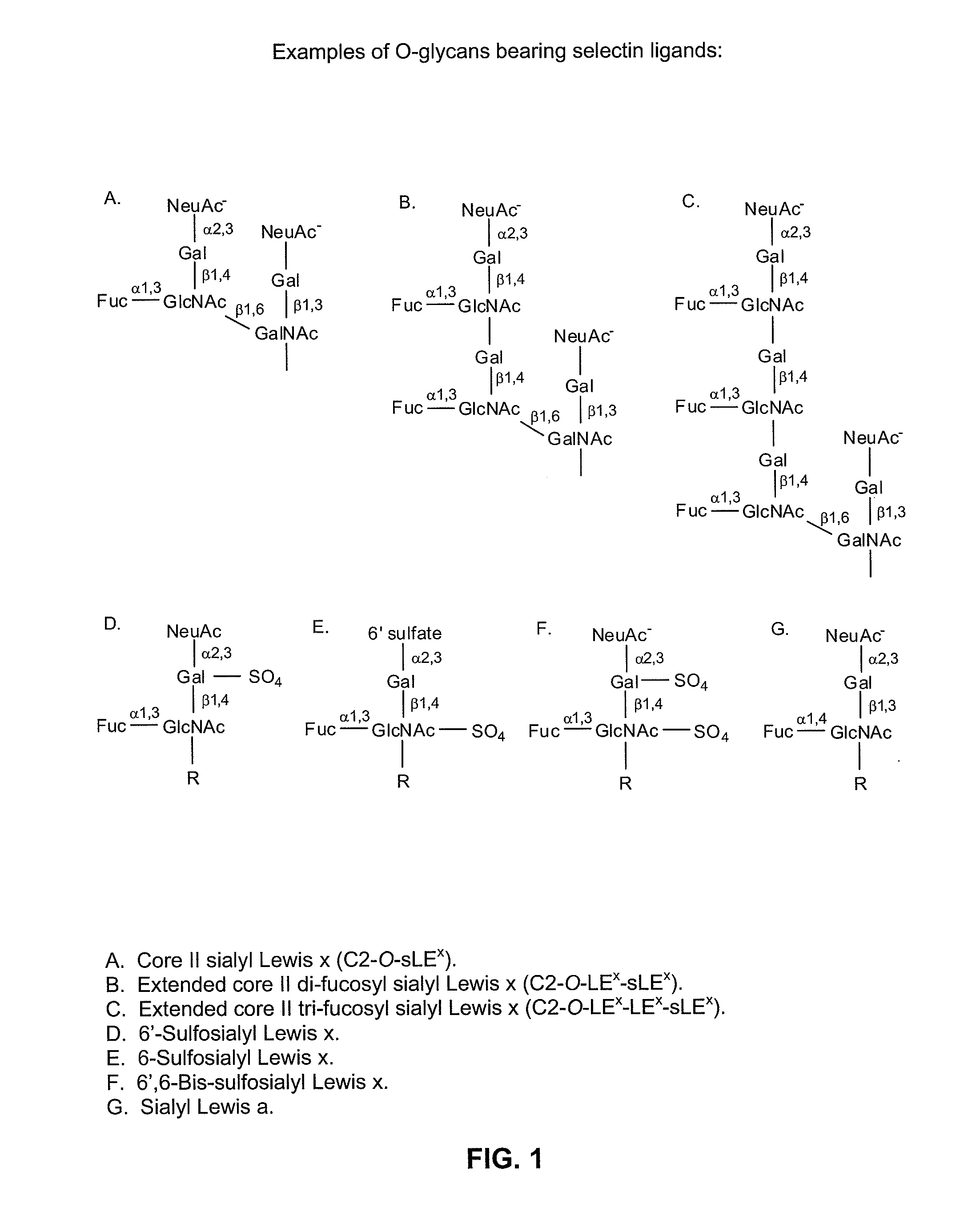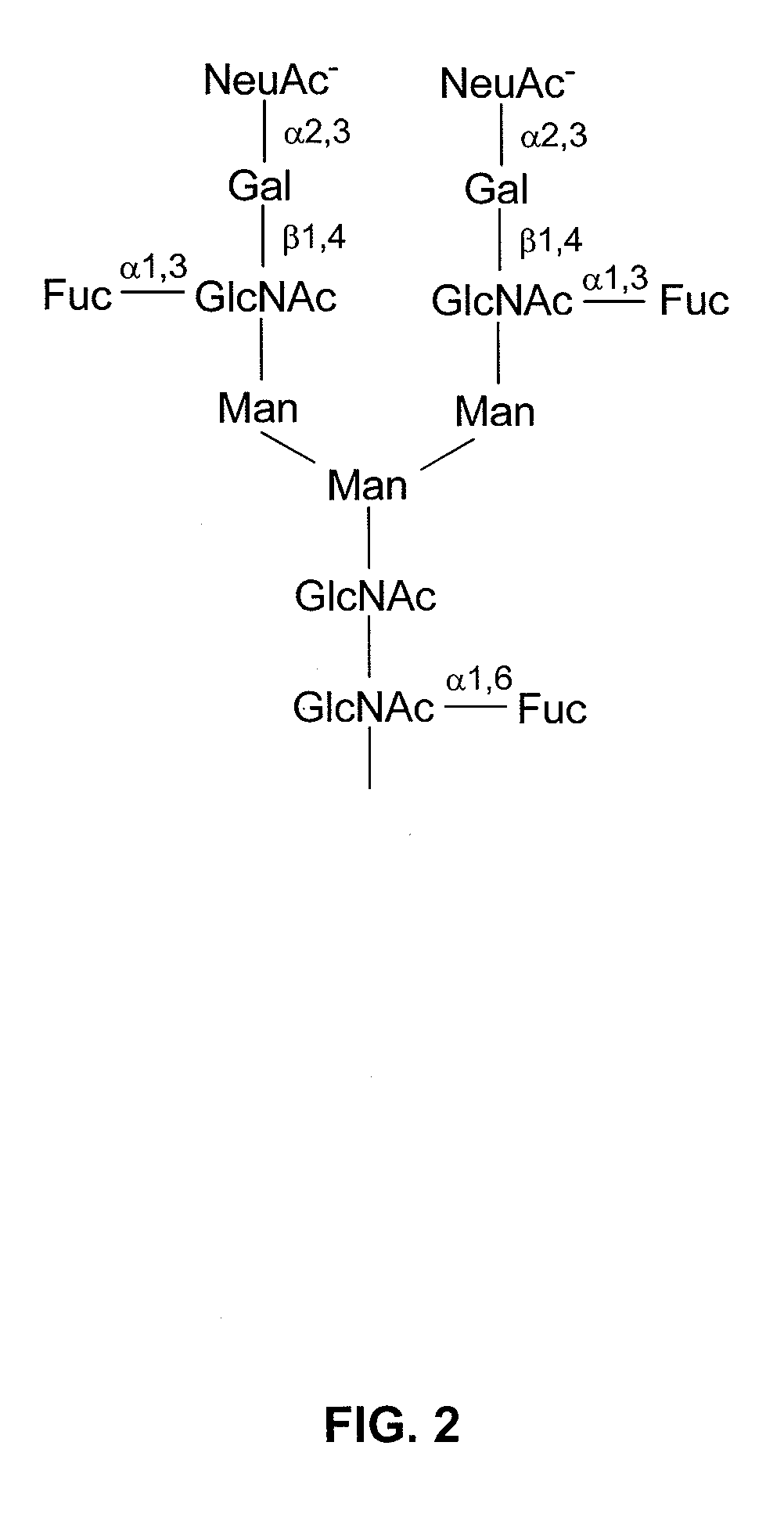In vitro modification of glycosylation patterns of recombinant glycopeptides
a glycosylation pattern and recombinant technology, applied in the field of methods for modifying the glycosylation pattern on glycopeptides, can solve the problems of expression level and inferior glycosylation pattern
- Summary
- Abstract
- Description
- Claims
- Application Information
AI Technical Summary
Benefits of technology
Problems solved by technology
Method used
Image
Examples
example 1
[0169]Example 1 sets forth the introduction of sialyl Lewis x structures onto a peptide using sialylation and fucosylation in vitro.
[0170]1.1 Sialylation of Recombinant Glycopeptide
[0171]A glycopeptide was dissolved at 2.5 mg / mL in 50 mM Tris, 0.15M NaCl, 0.05% NaN3. The solution was incubated with 5 mM CMP-sialic acid and 0.1 U / mL ST3Gal3 at 32° C. for 2 days. To monitor the incorporation of sialic acid, a small aliquot of the reaction had 14C-CMPSA added; the label incorporated into the peptide was separated from free label by gel filtration on a TosoHaas G2000SWx1 column in 45% MeOH, 0.1% TFA. The radioactivity incorporated into the peptide was quantitated using an in-line scintillation detector. The fraction of label incorporated was found to be 0.073 after 1 day, and 0.071 after two days, indicating that the sialylation reaction was complete in less than 24 hours.
[0172]1.2 Fucosylation of the Sialylated Peptide
[0173]To the glycopeptide prepared as describe in Example 1.1, GDP-f...
example 2
[0176]Example 2 sets forth the results of an investigation into the substrated specificity and fucosylation activity of two fucosyltransferases, FucT-V and FucT-VI.
[0177]2.1 Comparison of Fucosylation Using FucT-V and FucT-VI
[0178]Sialylated protein from Example 1.1 was dissolved to a concentration of 2.5 mg / mL, and incubated at 32° C. with 5 mM GDP-fucose, 5 mM MnCl2, 2 mU / mL of alkaline phosphatase, and 0.05 U / mL of either FucT-V or FucT-VI. After an overnight incubation, incorporated fucose was estimated as described above.
[0179]2.2 Results
[0180]The mole fraction of GDP-fucose incorporated into protein was 0.016 for FTV, and 0.13 for FTVI. Thus, approximately 8-fold more fucose was incorporated using FTVI compared to FTV.
example 3
[0181]Example 3 sets forth an exemplary fucosylation process of the invention utilizing the protein RsCD4 as a substrate for fucosylation. The fucosylation step is preceded by a sialylation step.
[0182]3.1 Sialylation of RsCD4
[0183]RsCD4 (2.5 mg / mL) was dissolved in 25 mM Na phosphate, 0.15M NaCl, 0.05% NaN3, and was incubated at 32° C. with 5 mM CMPSA and 0.1 U / mL ST3Gal3 for 2 days. After dialysis to remove CMPSA, an aliquot was subjected to N-glycan profiling by FACE according to the GLYKO protocol.
[0184]3.2 Results of Sialylation
[0185]The results of the sialylation reaction are set forth in FIG. 4. In FIG. 4, the native material contains a variety of glycoforms corresponding to bi-antennary glycans with 0.1, or two sialic acids, with and without core fucose. After sialylation, the predominant band is at DP 6.2, which corresponds to a core-fucosylated, disialylated, bi-antennary glycan. The lower band (DP ˜5.9) is a non-core fucosylated, disialylated bi-antennary glycan.
[0186]3.3 ...
PUM
| Property | Measurement | Unit |
|---|---|---|
| concentration | aaaaa | aaaaa |
| concentration | aaaaa | aaaaa |
| temperature | aaaaa | aaaaa |
Abstract
Description
Claims
Application Information
 Login to View More
Login to View More - R&D
- Intellectual Property
- Life Sciences
- Materials
- Tech Scout
- Unparalleled Data Quality
- Higher Quality Content
- 60% Fewer Hallucinations
Browse by: Latest US Patents, China's latest patents, Technical Efficacy Thesaurus, Application Domain, Technology Topic, Popular Technical Reports.
© 2025 PatSnap. All rights reserved.Legal|Privacy policy|Modern Slavery Act Transparency Statement|Sitemap|About US| Contact US: help@patsnap.com



